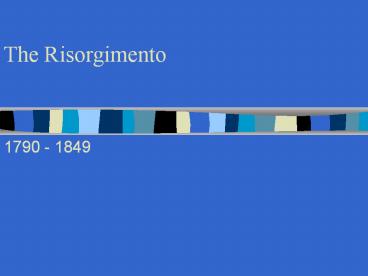The Risorgimento - PowerPoint PPT Presentation
Title:
The Risorgimento
Description:
1796 Napoleon's conquest of Italy. 1797 Venice is placed under Austrian sovereignty. The Cisalpine Republic (under Napoleon's control) included Bologna, Ferrara ... – PowerPoint PPT presentation
Number of Views:111
Avg rating:3.0/5.0
Title: The Risorgimento
1
The Risorgimento
- 1790 - 1849
2
- 1796 Napoleons conquest of Italy
- 1797 Venice is placed under Austrian sovereignty
- The Cisalpine Republic (under Napoleons control)
included Bologna, Ferrara and Milan - Liguria and Genoa became the Ligurian republic
- In Rome (1797-8) a republic was established
- 1796-99 Time of great hopes and expectations. The
triennio, ideological foundation of the
RISORGIMENTO (Vittorio Alfieri) - 1798 In Naples the Parthenopean republic
3
- 1800 Napoleon names the Cisalpine the Italian
republic - 1804 Napoleon crowns himself emperor. Italian
republics become kingdoms - Napoleons code is introduced
a) excessive respect for private property
b) rights of workers were not
emphasizes c) authority of the
father emphasized - Negatives
a) tax increases b) conscription
c) looting of art
4
- 1813 Napoleons defeat at Leipzig
- 1814 Napoleons exile on Elba
- 1815 Napoleons return to France (100 days),
defeat at Waterloo, final exile on Saint Elena
(dies on May 5th, 1821) - 1815 The Council of Vienna (Metternich) Absolute
monarchs return to Italy - Piedmont Vittorio Emanuele I
- Naples Ferdinand
- Parma, Modena, Tuscany Rulers related to the
Habsburgs
5
- Restoration represented a less than hoped return
to a previous age - Professional classes, intellectuals and
Napoleons soldiers had hoped for a more
representative political system - Secret societies were formed and were composed of
intellectuals, members of the educated class,
army officers - Carbonari revolutionary ideals and methods,
demands were not extreme (constitution) - Masons low abiding, no threat to the regime
6
- 1820-21 Carbonari riots in Turin and Naples
constitutions granted and then recalled - Prince Metternich (Troppeau Doctrine) assures
complete control of all revolutionary movements
in Italy - Giuseppe Mazzinis republican goals
a) Independence
b) Unity
c) Freedom for the Individual - Nationalism a romantic reaction to the ideals
of the Enlightenment
7
- The Enlightenment had believed in the universal
(rational laws and behavior could be applied
universally). The Romantics proclaimed the
importance of the individual (values, emotion,
imagination) on the political level this
ideology translates into an emphasis on national
characteristics and diversities - In Italy Mazzini (Genova, 1805). Studied law.
Wrote passionate essays in defence of
Romanticism. Envisioned a movement for Italian
nationhood and political freedom. Main
philosophical influences are Johann Gottfried
Herder and Saint Simon - Formed the Giovane Italia in 1831
- 1833 failed attempt at an insurrection Turin and
Genua
8
- 1834 Another attempt fails. Exile in Switzerland
until 1837 - During the exile Mazzini establishes La giovane
Europa - From 1837 Mazzini settles in England (will be in
Rome during the Roman Republic) - Gioberti (1801-52) Of the Moral and Civil Primacy
of the Italians suggested a path for future
greatness. He envisioned a conferderation of
Italian states ruled by the pope. - Cesare Balbo The Hopes of Italy. Envisions a
united state under the military leadership of
Piedmont - Massimo dAzeglio. Believes that the public
pressure in favor of Italian independence will
ultimately drive the Austrians out
9
- Piedmont
- 1847 Carlo Alberto follows Pius IXs example,
newspapers are founded and in 1848 the Statuto is
issued. It will become the basis for the future
Italian constitution (1861) - Monarchy was still in power a two chamber
parliament the upper selected by the crown, the
lower elected by literate tax payers - 1848 Metternich is forced to resign. Hungary and
the Tchecs demand liberal institutions. At this
time Milan rises against Austria. After five days
(le cinque giornate di Milano) general Radetzky
is forced to withdraw - Carlo Cattaneo, economist and political scientist
envisioned Italy as it was to become a federal
(regional) republic
10
- The Milanese conservative aristocrats took over
the power and asked the annexation of Lombardy
into the Piedmontese state - Carlo Alberto declares war on Austria (March 23,
1848), Venice declares its desire to be annexed
to Piedmont (Daniele Manin fails to organize the
Venetians who are inclined to form an independent
republic) - In April the pope withdraws his forces, Austria
attacks and defeats Piedmont at Custoza and
reoccupies Lombardy - Giuseppe Garibaldi (1807-82) returned to Italy
after fighting in South America and is placed in
command of the Roman republics army, while
Mazzini has executive powers. The repubic was
defeated by the French
11
- Carlo Alberto wages war on Austria again and
again is defeated. Abdicates and dies in Portugal - 1848-9 Venice is again a republic but is defeated
by Austria - Age of Romanticism in Italy Melodrama
- Gioacchino Rossini (1792-1868)
- Gaetano Donizetti (1779-1848)
- Vincenzo Bellini (1813-1901)
- Literature
- Alessandro Manzoni (I promessi sposi)
- Ippolito Nievo (Le confessioni di un Italiano)
- Ugo Foscolo (1778-1827), Giacomo Leopardi
(1798-1837)































![get [PDF] Download Growing Up Italian-American: The Memoirs of Ferdinand Visco & The Stories of PowerPoint PPT Presentation](https://s3.amazonaws.com/images.powershow.com/10050345.th0.jpg?_=20240607115)